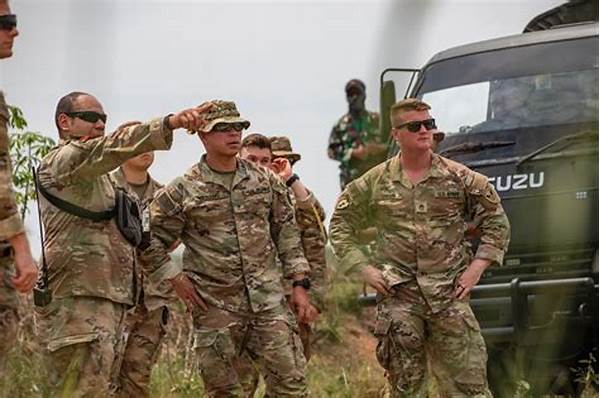The Importance of Interoperability in Military Partnerships
Interoperability in military partnerships is a critical factor in ensuring the seamless collaboration between various national defense forces. This is particularly evident when nations come together under a coalition or alliance such as NATO, where cohesion, mutual understanding, and unified operations are paramount. The ability to work effectively with forces from other countries enhances mission success, optimizes resource utilization, and bolsters defense capabilities in the face of potential threats. Interoperability encompasses a wide array of components, including communication protocols, standardized operating procedures, shared technologies, and logistical support systems. When military assets and personnel from different nations can communicate and operate using integrated systems, the synergy achieved significantly contributes to enhancing tactical and strategic outcomes. Thus, facilitating interoperability in military partnerships not only strengthens collective defense capabilities but also acts as a deterrent to adversaries contemplating aggression against any coalition member. It demands rigorous training, regular joint exercises, collaboration on technological advancements, and commitment to shared objectives. As global security dynamics continue to evolve, fostering interoperability remains an indispensable aspect of contemporary military alliances.
Challenges of Achieving Interoperability
1. Technological disparities among partner nations pose significant hurdles to interoperability in military partnerships. The diversity in equipment and technology standards requires substantial alignment efforts to ensure effective collaboration.
2. Cultural and language differences may impede effective communication, impacting interoperability in military partnerships. Overcoming these barriers is vital to maintaining cohesion and mission readiness.
3. Divergent political and strategic priorities among allied nations can affect the degree of interoperability in military partnerships. Aligning objectives is essential to foster cohesive operations.
4. Variances in military doctrine and operational procedures necessitate harmonization to achieve interoperability in military partnerships. This requires extensive training and comprehensive understanding across allied forces.
5. Financial constraints and resource allocation discrepancies can challenge the sustainability of interoperability in military partnerships. It is essential to address these issues to enhance collaborative military effectiveness.
Historical Perspectives on Interoperability
Examining historical contexts provides valuable insights into the evolution of interoperability in military partnerships. During World War II, the successful collaboration between the Allies illustrated the significance of combined efforts, pooling resources, and standardizing methods to achieve victory. The coordination seen during this period laid the foundational principles for contemporary military alliances. The lessons drawn emphasize the importance of fostering common communication channels, logistic compatibility, and shared strategic goals. Such historical precedents highlight that despite technological advancements, the core tenets of interoperability remain constant, driven by the need for a cohesive and united front. As security challenges have diversified, and technological races have intensified, understanding past successes continues to guide the strategies employed by modern intergovernmental military coalitions. Therefore, a historical lens on interoperability in military partnerships informs current practices and prepares forces to adapt to emerging threats and opportunities.
Enhancing Interoperability through Technology
1. The advent of digital communication systems has significantly improved interoperability in military partnerships, enhancing real-time coordination among allied forces during operations.
2. Standardized software solutions ensure seamless data exchange, crucial for the interoperability in military partnerships and synchronized multi-national missions.
3. Advanced training simulations incorporating shared technology facilitate a deeper understanding of interoperability in military partnerships, enhancing mission preparedness.
4. Common operational platforms enable streamlined logistic support, proving invaluable for maintaining interoperability in military partnerships.
5. Development of universally compatible technology interfaces promotes device and data compatibility, essential for achieving interoperability in military partnerships.
6. Cybersecurity measures tailored to protect joint communication networks reinforce interoperability in military partnerships, safeguarding mission-critical data.
7. Intelligent sensor systems offer real-time situational awareness, a cornerstone of interoperability in military partnerships, enabling informed decision-making processes.
8. Joint research collaborations foster cutting-edge technological innovations, pivotal to advancing interoperability in military partnerships.
9. Incorporation of blockchain technology strengthens data integrity and transparency, pivotal for ensuring interoperability in military partnerships.
10. Artificial Intelligence integration assists in strategic planning, potentially enhancing interoperability in military partnerships through predictive analytics and decision support systems.
Training for Interoperability
Effective training regimes are essential for achieving interoperability in military partnerships. Collaborative exercises simulate realistic battle scenarios, offering allied forces the opportunity to understand operational dynamics and strategize collectively. These exercises help identify gaps in communication, logistics, and tactical procedures, facilitating continuous improvement in joint operations. Training programs prioritize common protocols and language proficiency to overcome cultural and linguistic barriers, ensuring smoother interaction among personnel. Such initiatives accelerate the harmonization of different military doctrines into a cohesive modus operandi. By inculcating shared values and fostering mutual trust, joint training enhances the ability of multinational forces to execute complex missions seamlessly. Ultimately, training solidifies the foundation for interoperability, transforming theoretical alignments into practical operational effectiveness.
Strategic Benefits of Interoperability
The strategic advantages of interoperability in military partnerships are manifold. By ensuring that allied forces operate in harmony, coalition operations benefit from enhanced operational efficiency and tactical superiority. Interoperability enables flexible force deployment and optimizes resource allocation, leading to cost-effective mission execution. Furthermore, it enhances collective situational awareness, ensuring rapid response capabilities in dynamic threat environments. Interoperability also bolsters deterrence strategies, demonstrating a unified and potent front capable of countering aggressions with agility. As nations encounter complex global security challenges, the strategic value of effective interoperability becomes more pronounced, underscoring its critical role in securing peace and stability.
Conclusion: The Future of Interoperability
In summary, interoperability in military partnerships remains a key tenet for modern defense strategies, emphasizing the need for collaborative synergies across national borders. As geopolitical landscapes shift, the importance of seamless communication, shared technologies, and joint operations will only intensify. Future advancements will likely focus on overcoming existing challenges such as technology disparities and strategic misalignments. Continuous investment in training and technological innovation is vital for sustaining and elevating interoperability standards. The ever-evolving nature of warfare demands proactive measures to ensure that alliances stand resilient and adaptive. Therefore, reinforcing interoperability not only fortifies existing partnerships but also charts a robust path forward in the pursuit of global security and peace.





